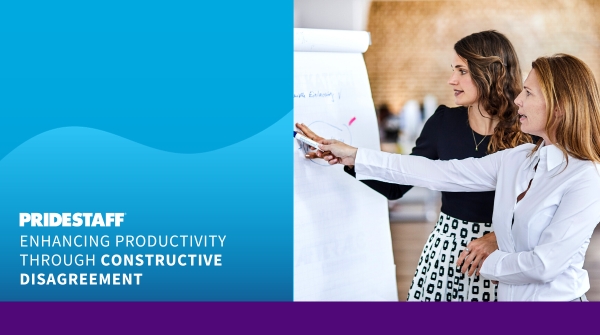Enhancing Productivity Through Constructive Disagreement

Harnessing the power of diverse perspectives is a proven way to enhance productivity and drive innovation. However, achieving this goal requires navigating through disagreement and conflict.
The key lies in transforming these disagreements into constructive discussions that yield collaborative outcomes—often a challenging feat in an emotionally charged situation.
When is Conflict Positive?
Conflict is often viewed with trepidation, but not all conflict is detrimental. In fact, conflict can be a catalyst for positive change when managed effectively. Positive conflict, or constructive disagreement, occurs when team members engage in open, respectful discussions to address differences in opinion or approach.
Positive conflict arises when team members:
- Challenge ideas, not people. In a healthy environment, conflict revolves around differing ideas and strategies rather than personal attacks. It involves scrutinizing the merits of various proposals, not attacking the individuals presenting them.
- Seek solutions. Positive conflict focuses on finding solutions to problems or challenges. It encourages team members to explore alternative approaches and consider different perspectives to arrive at the best outcome.
What are the Benefits of Constructive Disagreement?
Embracing constructive disagreement brings numerous benefits to your organization:
- Enhanced creativity and innovation. When team members engage in open debates, it encourages creative thinking and innovation. Diverse viewpoints can lead to novel solutions and approaches that wouldn’t have emerged in a conflict-averse environment.
- Improved decision-making. Constructive disagreement forces teams to critically evaluate options, leading to better-informed decisions. It minimizes the risk of “groupthink” and promotes well-rounded choices.
- Stronger relationships. Teams that navigate conflict constructively build stronger relationships based on trust and respect. Engaging in challenging discussions without personal animosity fosters a healthier work environment.
Top Tips to Boost Productivity Through Constructive Conflict
- Establish a culture of respect. Foster a workplace culture where respectful disagreement is encouraged. Make it clear that differing opinions are valued, and everyone’s voice is heard and respected.
- Listen actively. Encourage active listening during discussions. Ensure team members are fully engaged in understanding others’ perspectives before responding. This promotes empathy and mutual understanding.
- Set clear objectives. Define the purpose of each discussion or disagreement. Clarify the desired outcome and ensure everyone understands the goals. This helps prevent aimless conflicts and keeps discussions focused.
- Designate a facilitator. In larger discussions, appoint a facilitator to guide the conversation and ensure it remains constructive. A skilled facilitator can redirect conversations if they become unproductive.
Your Path to Productivity Starts with PrideStaff
Our local staffing and recruiting experts can provide you with the resources and support you need to build a team that thrives on diverse perspectives and drives your organization toward success. Take the first step toward transforming your workplace into a hub of creativity, innovation, and productivity. Contact your local PrideStaff office today!
Related Posts
How to Teach Young Team Members the Importance of Communication



